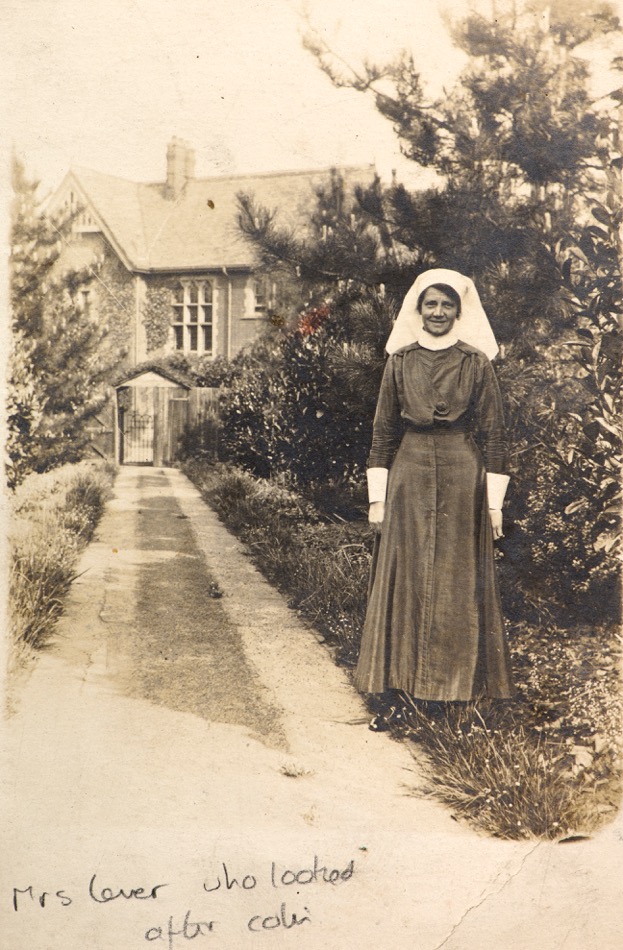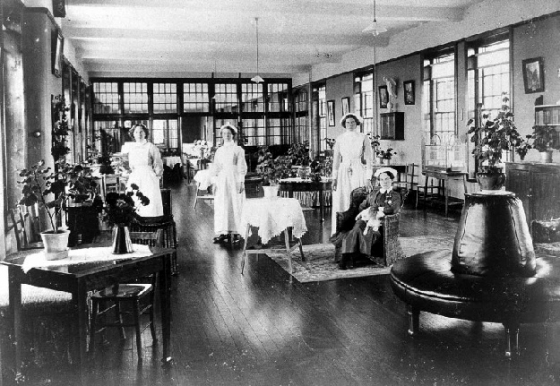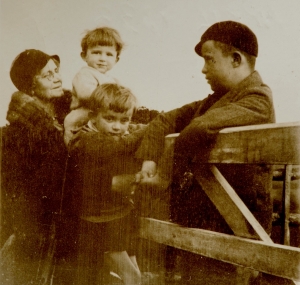ELLEN LEAVER* 1869–1951
Ellen Leaver in the grounds of Notts County Asylum, courtesy of the Simpson family
*Alternative spellings of ‘Leaver’ and ‘Lever’ are given in documents pertaining to her. The surname on the birth register is Leaver.
Ellen Lever worked at Notts County Asylum from 1902 when it opened until she retired in 1925. She never married and had a long career as Matron at the hospital, which included a period working there from 1918–1919 when the asylum was converted temporarily into a war hospital for ‘shell shocked’ servicemen.
Before the First World War
Ellen was born on 6 September 1869. She was the daughter of Thomas and Emma Lever. In 1871, age two, she was living with her parents, grandparents and her sister Mary (age four) in New Basford, Nottinghamshire. Her father was a fitter in a Nottingham lace factory. Her brother Arthur was born in 1873, followed by her sister Ruth in 1875 and brother Edwin in 1879. By 1891 Emma Lever was a widow living in Radford, Nottingham, with her three daughters and two sons. Ellen (described as Nelly on the 1891 census) and her sisters were working in the lace industry.
In 1901 she was a nurse at the county asylum in Sneinton, Nottingham. It was unfit for purpose and due to be closed. A replacement asylum was being built at Saxondale, Notts, located two miles outside Radcliffe on Trent on a large hillside site of 230 acres. The buildings included twelve wards, providing accommodation for 452 patients, offices, a farm, dairy and bakery. Notts County Asylum opened in 1902. Patients were transferred from the old asylum in Nottingham as were some of its staff, including Ellen Lever. She became Matron in 1908. The 1911 census records the hospital as having thirty female nurses, who mainly came from outside the area, and nineteen male attendants (the common term for male nurses). There were 236 male and 258 female patients in residence. Ellen Lever’s job included overseeing the nurses and female house staff together with administrative matters. The hospital expanded in 1913 when extensions were built to accommodate an additional 148 patients. More staff were taken on to look after them. The asylum suffered from overcrowding and problems of staff retention throughout the pre-war period.
During the war
The war had a significant impact on the daily life of the asylum. Thirty-seven of the pre-war male staff were called up immediately and left the hospital, resulting in an acute shortage of attendants. The hospital’s annual reports for 1916 state The past year has been one of much anxiety, due to the large number of male staff who have joined the Forces, also the number of changes in the female staff. The strength of the male attendant staff has been much below the recognisable standard and it has been found impossible to obtain ‘ineligible’ men who are of suitable physique for the care of patients. The war brought constraints on patients’ activities. and food shortages. The asylum began to take in a few patients who were soldiers and sailors suffering from ‘shell shock’.
In July 1918, the asylum was requisitioned by the War Office and converted to Notts County War Hospital, resulting in considerable upheaval for patients and staff. Ellen Lever continued in post as Matron and would have been involved in new staffing arrangements. In addition, she would have helped organise the dispersal of 516 civil patients to other asylums in the war office’s Northern Region. She would then have had to adapt to a new medical team of military doctors and oversee the nursing of over a thousand servicemen who were admitted at various times over the ensuing year.
Notts County War Hospital stayed open until August 1919, providing care for patients suffering from war trauma. During that time twenty-nine patients died, some from influenza and tuberculosis and others from various illnesses including ‘mania’. There was one confirmed suicide (see Harry Smith’s biography). Much was done to entertain servicemen whose condition enabled them to attend the newly installed cinema, lectures, football and cricket matches between wards and dances, which were especially enjoyed. In August 1919 Notts County War Hospital was disbanded. The premises were closed for three months for refurbishment and remaining patients were discharged or dispersed. The Asylum reopened on November 11th, 1919, now renamed Notts County Mental hospital under the jurisdiction of the newly formed Ministry of Health. Over the next two weeks 456 of the original civil patients returned (sixty remained where they were sent in 1918). Ellen Lever welcomed them back. She was praised for her work at the War Hospital by S. Lloyd Jones, Medical Superintendent:
‘I must specially commend the work of Miss Lever (Matron). Her knowledge of nursing and domestic administration, and her untiring efforts and constant efficiency cannot be too highly praised’.
Nurses and matron at Saxondale Hospital in the 1920s. The matron, seated, may be Ellen Leaver.
Photograph Radcliffe on Trent Local History Society
After the war
The hospital suffered from staff shortages after the war. Only a few of the nurses who had worked at the asylum before it became a war hospital were still in post and those brought in by the war office had left. The doctors and Matron Ellen Lever had to employ a new team of nurses, many of whom lacked experience and whose training had to begin from scratch. Staff turnover would have had an impact on Ellen Lever’s workload, especially with regard to overseeing and training the new female nurses.
Forty-four male staff served in the war but not all returned. Jobs were kept open for the twenty-two permanent male nurses, following successful negotiations by the National Asylum Workers Union. Those who returned to work at the hospital included William Buxton, George Faulkner, Edward Gamble, Walter Gibson, John Johnson, John Mason, George Smith, Thomas Stratton, Wilfred Taylor. Archibald Simpson came back to his job as deputy Clerk and Steward. He was promoted to Clerk and Steward at the end of the 1920s, following the retirement of John Gell. A large number of new, male nurses were appointed, mostly untrained. They included Bert Bakewell, Ernest Franklin, Charles Vickerstaff and Leonard Vickerstaff.
1922 Strike
In April 1922 the nurses went on strike after the authorities proposed to increase their hours to sixty-six a week and reduce their wages, followed by demands to sign new work contracts. All but four of the female nurses came out on strike as did around half of the male nurses. They were strongly supported by the National Asylum Workers Union. The strike lasted for two days. Nurses locked themselves in their wards with their patients, together with kitchen staff who supplied food. All the strikers were forcibly evicted by a large group of police, bailiffs and ground staff. Seventy-three employees, including nurses and house staff, were sacked for ‘insubordination’ or ‘misconduct’ by Notts County Council, who were responsible for managing the hospital.
Ellen Lever’s reaction to the strike has not been described in newspaper accounts.
Retirement
The hospital minutes for July 14th 1924 state that ‘the Chairman had discussed with Miss Lever the question of her retirement and superannuation. Resolved that the Matron be granted an honorarium of twenty-five pounds (£25) and also one month’s special sick leave for the benefit of her health’. Ellen Leaver resigned in October. At the monthly meeting, the clerk ‘read the letter dated 24th October 1924 from Miss Lever requesting permission to retire on superannuation allowance on 5th February 1925. Resolved that this resignation be accepted with regret, and that the question of superannuation allowance and the appointment of her successor is considered at the next meeting.‘ A farewell party was held for her at the hospital on the 14th February 1925.
Ellen Lever retired at the age of fifty five after twenty-four years of service at the hospital. She then took care of Archibald Simpson’s son. Archibald had married the deputy matron of the hospital, Jane (Jennie) Jones in 1913. Their son was born in 1920 and named after Archibald’s brother, Leslie Colin, who was killed in action in 1915. Jane died the following year in 1921.
Ellen Lever in the 1930s, courtesy of the Simpson family
Leslie Colin Simpson had Down’s Syndrome. He came to live with Ellen in 1926 after she bought and moved into 24 Hampton Road in West Bridgford. He died in 1947 at the age of twenty-seven and it is thought that he was still living at this address. Descendants of Archibald Simpson recall that the family was very fond of Ellen and referred to her as ‘Auntie Lever’. She was living at 24 Hampton Road when she died on 25th September 1951 at the age of eighty-two.
Author
Rosie Collins



